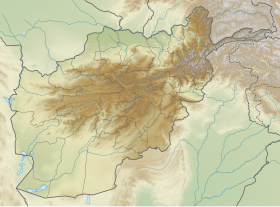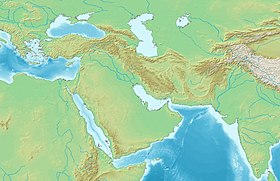Draft:Siege of Bamyan (1221)
 | Review waiting, please be patient.
This may take 2 months or more, since drafts are reviewed in no specific order. There are 2,223 pending submissions waiting for review.
Where to get help
How to improve a draft
You can also browse Wikipedia:Featured articles and Wikipedia:Good articles to find examples of Wikipedia's best writing on topics similar to your proposed article. Improving your odds of a speedy review To improve your odds of a faster review, tag your draft with relevant WikiProject tags using the button below. This will let reviewers know a new draft has been submitted in their area of interest. For instance, if you wrote about a female astronomer, you would want to add the Biography, Astronomy, and Women scientists tags. Editor resources
Reviewer tools
|
| Submission declined on 4 February 2025 by AirshipJungleman29 (talk). This submission's references do not show that the subject qualifies for a Wikipedia article—that is, they do not show significant coverage (not just passing mentions) about the subject in published, reliable, secondary sources that are independent of the subject (see the guidelines on the notability of events). Before any resubmission, additional references meeting these criteria should be added (see technical help and learn about mistakes to avoid when addressing this issue). If no additional references exist, the subject is not suitable for Wikipedia. The proposed article does not have sufficient content to require an article of its own, but it could be merged into the existing article at Mongol invasion of the Khwarazmian Empire. Since anyone can edit Wikipedia, you are welcome to add that information yourself. Thank you.
Where to get help
How to improve a draft
You can also browse Wikipedia:Featured articles and Wikipedia:Good articles to find examples of Wikipedia's best writing on topics similar to your proposed article. Improving your odds of a speedy review To improve your odds of a faster review, tag your draft with relevant WikiProject tags using the button below. This will let reviewers know a new draft has been submitted in their area of interest. For instance, if you wrote about a female astronomer, you would want to add the Biography, Astronomy, and Women scientists tags. Editor resources
This draft has been resubmitted and is currently awaiting re-review. |  |
| Submission declined on 1 January 2025 by Snowycats (talk). The proposed article does not have sufficient content to require an article of its own, but it could be merged into the existing article at Mongol invasion of the Khwarazmian Empire. Since anyone can edit Wikipedia, you are welcome to add that information yourself. Thank you. Declined by Snowycats 37 days ago. |  |
| This is a draft article. It is a work in progress open to editing by anyone. Please ensure core content policies are met before publishing it as a live Wikipedia article. Find sources: Google (books · news · scholar · free images · WP refs) · FENS · JSTOR · TWL Last edited by Shadow. 547 (talk | contribs) 3 seconds ago. (Update)
This draft has been submitted and is currently awaiting review. |
This article has multiple issues. Please help improve it or discuss these issues on the talk page. (Learn how and when to remove these messages)
|
The siege of Bamiyan took place in 1221 under the leadership of Genghis Khan during the Mongol pursuit of Jalal al-Din Mangburni, the last ruler of the Khwarazmian Empire, which led to a brutal and devastating attack that left the city in ruins[1]
| Siege of Bamiyan | |||||||
|---|---|---|---|---|---|---|---|
| Part of the Mongol invasion of the Khwarazmian Empire | |||||||
 Only ruins remain of the city from the siege | |||||||
| |||||||
| Belligerents | |||||||
| Mongol Empire | Khwarazmian Empire | ||||||
| Commanders and leaders | |||||||
| Genghis Khan[3] | Jalal al-Din Mangburni | ||||||
| Strength | |||||||
| 200,000[4] | Unknown | ||||||
| Casualties and losses | |||||||
| Unknown | Heavy | ||||||
Location of the siege on a map of modern Afghanistan | |||||||
Background
[edit]The siege occurred while the Mongols were pursuing Jalal al-Din Mangburni, The last ruler of the Khwarazmian Empire where Jalal al-Din Mangburni had formed a new Muslim army in Afghanistan[5]
The Siege
[edit]The Mongol army led by Genghis Khan besieged the city of Bamiyan in 1221[6]. The city's defenses were strong, but the Mongols were determined to capture it. After fierce resistance the Mongols breached the walls and captured the city[7]. During the siege Mutukan the son of Chagatai Khan and grandson of Genghis Khan was killed in the battle by an arrow from the city walls[8] This death, compounded by the heavy casualties sustained by his army, angered Genghis Khan to such an extent that once he captured Bamiyan, Genghis Khan gave orders that every living creature to be killed, and all the defenders to be killed aswell. He ordered the city's complete destruction and the annihilation of its population, as well as the surrounding areas. The devastation was so total that the Mongols themselves would later refer to Bamiyan as "the city of sorrows" and "the city of noise (or screams)", a haunting testament to the cries of its slaughtered inhabitants. The ruins of the citadel, and the crumbling remains of the old city, are still clearly, eerily, visible from modern day Bamiyan and Genghis Khan caused no further damage to the Buddha images[9][10][11][12]
Aftermath
[edit]After capturing Bamiyan, Genghis Khan then marched on, hunting down Jalal ad-Din Mingburnu into the Indian territory[13]
The Siege of Bamiyan was marked by widespread destruction and violence[14]
It is said that after the local Afghan population was devastated, Genghis Khan resettled the area with Mongol troops and their female captives to maintain control while he continued his conquest. These early settlers would eventually become the ancestors of the Hazara people, with the name "Hazara" possibly originating from the Persian phrase "yek hezar," meaning "one thousand," which referred to a Mongol military unit of 1,000 soldiers[15][16]
Legacy
[edit]Today, the site of the ancient city of Bamiyan is a UNESCO World Heritage Site[17] The city's famous Buddha statues, although destroyed by the Taliban in 2001[18] remain an important cultural and historical symbol of the region[citation needed].
See also
[edit]References
[edit]- ^ "City of Screams: Gholghola". Visit Bamiyan. Retrieved 2025-02-04.
- ^ John, Joseph Saunders (1971). The history of the Mongol conquests. London, Routledge & K. Paul. ISBN 0-71-007073-X. p. 218.
- ^ Morgan, Llewelyn (2012). The Buddhas of Bamiyan. Harvard University Press. ISBN 978-0-674-05788-3.
- ^ Romano, Amy (2003). A historical atlas of Afghanistan. New York : Rosen Pub. Group. ISBN 0823938638. p. 25.
- ^ Kohn, George C (2007). Dictionary of wars. New York : Facts on File/Checkmark Books. p. 55.
- ^ Kohn, George C (1986). Dictionary of wars. New York, N.Y. : Facts on File. ISBN 0816010056. p. 48.
- ^ Morgan, Llewelyn (2012). The Buddhas of Bamiyan. Cambridge, Mass. : Harvard University Press. ISBN 9780674057883. p. 36.
- ^ Behnke, Alison (2008). The Conquests of Genghis Khan. Minneapolis : Twenty-First Century Books. ISBN 9780822575191. p. 106.
- ^ "Shahr-e Gholghola in Bamiyan, Afghanistan". Lonely Planet. 2011-09-28. Retrieved 2012-05-09.
- ^ Romano, Amy (2003). A historical atlas of Afghanistan. New York : Rosen Pub. Group. ISBN 0823938638. p. 25.
- ^ "Remembering Bamiyan". Archived from the original on 2013-10-04.
- ^ Roux, Jean-Paul (2003). Genghis Khan and the Mongol empire. New York : Harry N. Abrams. ISBN 0810991039. p. 124.
- ^ Behnke, Alison (2008). The conquests of Genghis Khan. Minneapolis : Twenty-First Century Books. ISBN 9780822575191. p. 107.
- ^ Dupree, Nancy Hatch (1967). The Valley of Bamiyan. Kabul; Afghan Tourist Organization. p. 42.
- ^ Metcalfe, Daniel (2010). Out of Steppe. London : Arrow Books. ISBN 9780099524991. p. 168.
- ^ Weatherford, J. Mclver (2004). Genghis Khan and the making of the modern world. New York : Crown. ISBN 0609610627. p. 118.
- ^ "Cultural Landscape and Archaeological Remains of the Bamiyan Valley". UNESCO World Heritage Centre. Archived from the original on 28 January 2007. Retrieved 2 August 2022.
- ^ Morgan, Llewelyn (2012). The Buddhas of Bamiyan. Harvard University Press. p. 15. ISBN 978-0-674-06538-3.


